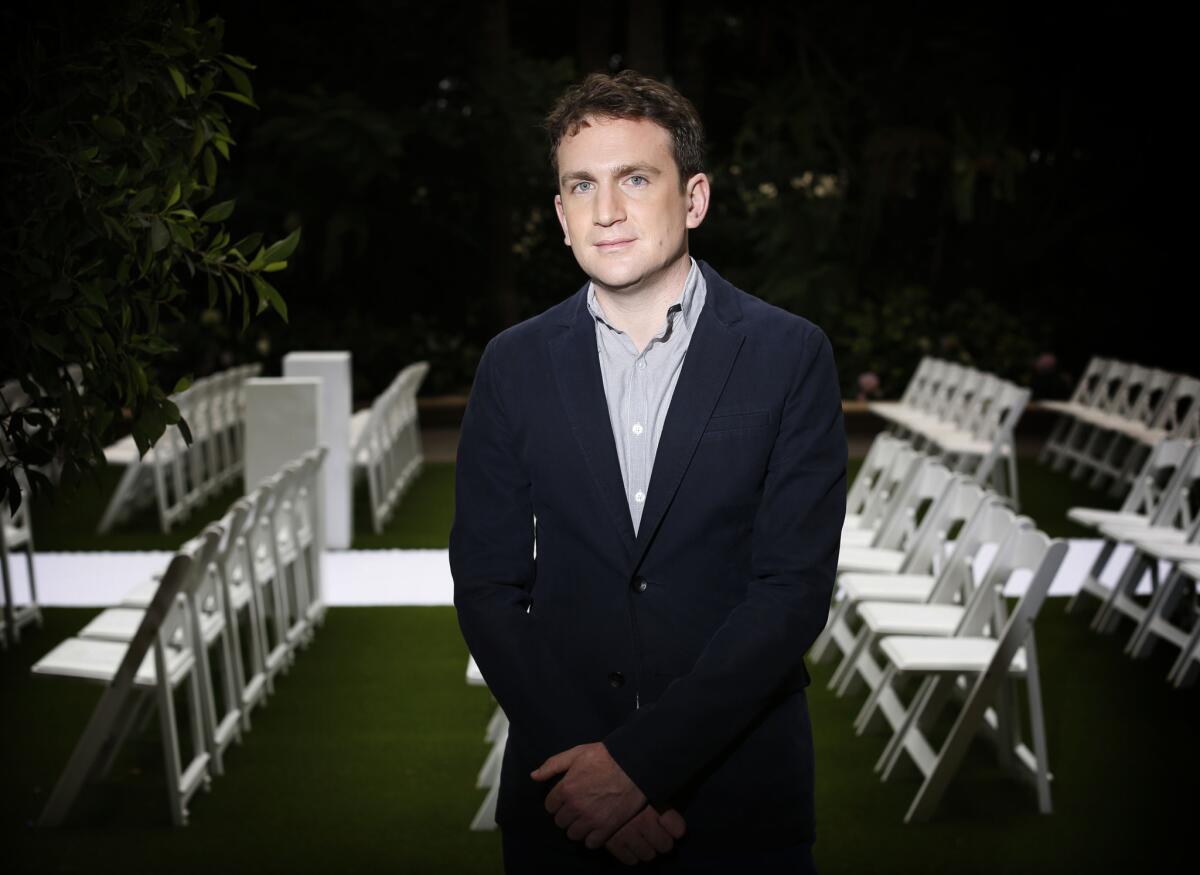For teen romance ‘Paper Towns,’ Jake Schreier draws from ... Scorsese?

Jake Schreier is part of a larger class of contemporaries tackling big studio material just a short time after a quirky passion project.
Reporting from Brooklyn, N.Y. — The names of many different movies might come up if you’re discussing “Paper Towns,” the new millennial romance from the novelist and screenwriters behind last year’s teen weepie “The Fault in Our Stars.”
“Casino” and “The Big Sleep” are not among them.
Yet those reference points kept running through the mind of director Jake Schreier as he was making his new film, about a high-school senior (Nat Wolff) pining for a free-spirited neighbor (Cara Delevingne) after she disappears.
“There is a mystery and a search and a femme fatale, so ‘The Big Sleep’ and ‘The Long Goodbye’ felt right,” said Schreier, who showed a number of classic noir movies to his cast.
And “Casino”?
“OK, maybe not the story. But the framing, and the bigness of some of the scenes about people in high school, which is the same bigness Scorsese used in that movie,” Schreier said, then laughed knowingly at the outsized comparison.
The geekish helmer looks to tap into those unlikely influences in his new film, even as he plays to a more traditional teen narrative about Q, the hero played by Wolff.
As written by the “Fault” novelist John Green and screenwriters Scott Neustadter and Michael H. Weber, Q (short for Quentin) is neither cool nor an outcast. He is merely a reasonably bright high school senior with plans for Duke medical school when he graduates and leaves his Orlando, Fla., neighborhood behind. OK, so maybe he has some unresolved feelings for neighbor and childhood friend Margo (Delevingne, the supermodel in her biggest role to date), who’s since gone on to hang with the popular kids and whose life he romanticizes. It’s nothing a little graduation can’t cure.
Yet when Margo enlists Q on a revenge mission one night and then disappears the next day, it sets the hero and his friends on a path to find her (with the help of some clues she’s left behind) — and, possibly, to make more existential discoveries too.
Schreier scatters “Paper Towns,” which Fox will release Friday, with his own bread crumbs. Some of the cinematic nods are obvious — Q and his friends attempt a Humphrey Bogart-Philip Marlowe voice as they begin their quests. Others are more subtle, such as a few mood-music driving scenes at dusk that will recall 1980s’ neon-noir titles like “Body Double,” nighttime shots using lights and shadow that seems out of a classic noir, or even shots of the boys on their quest that will evoke adventure-minded throwbacks like “The Goonies.”
Schreier, 33, is an unlikely person to tackle this teen material. Just three years ago, he made “Robot & Frank,” a gentle futuristic story about an aging burglar and his new pet machine. The movie had its premiere at Sundance, where it received nice notices and a modest release. Schreier seemed likely to move to a prestige drama, or maybe a slightly bigger science-fiction movie.
But the director was hardly a sci-fi guy — his parents wouldn’t even allow him to see “Aliens” in their Berkeley home when he was grouping up— and he didn’t want to repeat the feat in any event. He read the “Paper Towns” novel and thought it a fitting way to branch out, then sold himself to Fox 2000 and production company Temple Hill as the kind of director who’s adept at humanism with a genre dusting.
“I’m not sure there are a lot of comparisons, but if you’re going to draw a line from ‘Robot & Frank’ to this movie it’s that they each have a bunch of genres that really shouldn’t be in the same film but need to be held together,” he said last week at a restaurant in Brooklyn, where he lives.
Schreier is part of a larger class of contemporaries tackling big studio material just a short time after a quirky passion project. “Jurassic World” director Colin Trevorrow scored the biggest hit of the summer a few years after making the offbeat Sundance time-travel dramedy “Safety Not Guaranteed,” while Schreier’s friend and New York University classmate Jon Watts has gone from the indie road thriller “Cop Car” to the new “Spider-Man” movie before the former has even hit theaters.
But as much as the jumps suggest the movie industry’s willingness to do away with dues-paying, they also reflects a reality about today’s directors: If you want to work in tentpole-era Hollywood, you’d better be ready to mold your style to a studio’s slate and needs.
The adaptation process on “Paper Towns” in particular wasn’t easy. Green’s novel, written four years before “Fault,” lacks the dramatic hook of his later success, not to mention the baroque conceits of a “Twilight” or “Hunger Games.” Though there is a missing-persons element to the Margo tale, that’s hardly the movie’s point. The biggest mystery in “Paper Towns” is the puzzle of growing up.
“We are the no-one-dies movie,” Schreier said, smiling as he made clear he’s heard the question a few times before. “It is a little unfortunate no one turns into a vampire.”
And while the book does contain a big road trip — a section that becomes a pièce de résistance of the film — there are other less filmable elements, such as when Q reads chunks of Walt Whitman to help track down Margo. (The prose appears on screen, fleetingly.)
Green said he had his own doubts about the project. “I didn’t see it as very adaptable, to be honest,” said the novelist, who was on set during the shoot advising Schreier and the actors. “But Scott and Mike and Jake found a structure that worked, [as they did] this through-line of all these people mis-seeing or essentializing each other, which I thought really captured the book.
“It’s nice to have a movie for young people that doesn’t fit into genre expectations.” he added.
(Whether an audience accustomed to seeing their teen concerns in shiner packaging will agree remains a question; but judging by the youthful shrieks at the premiere on Tuesday, the studio at least has a devoted fan base to work with.)
To adapt material like this, it also helps to have a certain clarity of purpose. Schreier, who is soft-spoken, is said to manifest an intensity on set. “Has Jake managed to convince you he’s low-key?” Wolff said, laughing when told of a reporter’s impression of the director. “That’s good that’s he’s able to trick you.” Wolff also noted that “Fault,” which he co-starred in, required a filmmaker who could lighten heavy material like that movie’s Josh Boone. “Paper Towns,” which is inherently not as life-or-death, needed a certain seriousness behind the camera as a counterbalance.
And Schreier is certainly intense about his filmmaking. The director circles back to Steven Soderbergh as an influence several times, and in “Paper Towns” he sought, like Soderbergh might, to give a lived-in quality to heightened moments and to bring an attention to detail even to casual scenes.
Still, he said he also found there were elements he couldn’t control--such as the overall tone of the movie, which didn’t always flow from some of the individual choices. “It’s strange. I think I’m pretty dark and cynical, and these movies keep coming out light,” Schreier said. “But that’s OK. Nat called me Diet Fincher at one point. I can live with that.”
More to Read
Only good movies
Get the Indie Focus newsletter, Mark Olsen's weekly guide to the world of cinema.
You may occasionally receive promotional content from the Los Angeles Times.











